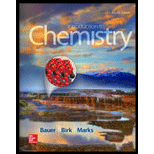
(a)
Interpretation:
The mass of silver carbonate formed after the completion of the given
(a)
Explanation of Solution
Given Information:
The molarity of silver nitrate solution is
Titration is a method to determine the concentration of a substance in the solution by making it react with a solution of known concentration of other substance, just beyond the point where the reaction between both the substances completes. In precipitation reactions, on the reaction of reactants, an insoluble end product is formed which precipitates out from the solution.
The chemical reaction for the formation of silver carbonate on the reaction of silver nitrate and sodium carbonate is,
Thus, two moles of silver nitrate react with one mole of sodium carbonate to form a mole of silver carbonate.
Convert volume units from milliliters to liters as follows:
Convert
Convert
Molarity of the solution
Substitute
Substitute
From the equation, it can be summarized that two moles of silver nitrate react with one mole of sodium carbonate to produce one mole of silver carbonate. Therefore,
Silver carbonate formed is as follows:
The molar mass of
The number of moles
Substitute
Thus, the mass of silver carbonate formed is
(b)
Interpretation:
The mass of silver carbonate formed after the completion of the given chemical reaction is to be determined.
(b)
Explanation of Solution
Given Information:
The molarity of silver nitrate solution is
The chemical reaction for the formation of silver carbonate on the reaction of silver nitrate and sodium carbonate is,
Thus, two moles of silver nitrate react with one mole of sodium carbonate to form a mole of silver carbonate.
Convert volume units from milliliters to liters as follows:
Convert
Convert
Substitute
Substitute
From the equation, it can be summarized that two moles of silver nitrate react with one mole of sodium carbonate to produce one mole of silver carbonate.
Silver carbonate formed is as follows:
The molar mass of
Substitute
Thus, the mass of silver carbonate formed is
(c)
Interpretation:
The mass of silver carbonate formed after the completion of the given chemical reaction is to be determined.
(c)
Explanation of Solution
Given Information:
The molarity of silver nitrate solution is
The chemical reaction for the formation of silver carbonate on the reaction of silver nitrate and sodium carbonate is,
Thus, two moles of silver nitrate react with one mole of sodium carbonate to form a mole of silver carbonate.
Convert volume units from milliliters to liters as follows:
Convert
Convert
Substitute
Substitute
From the equation, it can be summarized that two moles of silver nitrate react with one mole of sodium carbonate to produce one mole of silver carbonate.
Silver carbonate formed is as follows:
The molar mass of
Substitute
Thus, the mass of silver carbonate formed is
Want to see more full solutions like this?
Chapter 11 Solutions
Introduction to Chemistry
- Describe in words how you would prepare pure crystalline AgCl and NaNO3 from solid AgNO3 and solid NaCl.arrow_forwardYou are given four different aqueous solutions and told that they each contain NaOH, Na2CO3, NaHCO3, or a mixture of these solutes. You do some experiments and gather these data about the samples. Sample A: Phenolphthalein is colorless in the solution. Sample B: The sample was titrated with HCl until the pink color of phenolphthalein disappeared, then methyl orange was added. The solution became pink. Methyl orange changes color from pH 3.01 (red) to pH 4.4 (orange). Sample C: Equal volumes of the sample were titrated with standardized acid. Using phenolphthalein as an indicator required 15.26 mL of standardized acid to change the phenolphthalein color. The other sample required 17.90 mL for a color change using methyl orange as the indicator. Sample D: Two equal volumes of the sample were titrated with standardized HCl. Using phenolphthalein as the indicator, it took 15.00 mL of acid to reach the equivalence point; using methyl orange as the indicator required 30.00 mL HCl to achieve neutralization. Identify the solute in each of the solutions.arrow_forward
 Chemistry: Principles and PracticeChemistryISBN:9780534420123Author:Daniel L. Reger, Scott R. Goode, David W. Ball, Edward MercerPublisher:Cengage Learning
Chemistry: Principles and PracticeChemistryISBN:9780534420123Author:Daniel L. Reger, Scott R. Goode, David W. Ball, Edward MercerPublisher:Cengage Learning Introductory Chemistry: A FoundationChemistryISBN:9781337399425Author:Steven S. Zumdahl, Donald J. DeCostePublisher:Cengage Learning
Introductory Chemistry: A FoundationChemistryISBN:9781337399425Author:Steven S. Zumdahl, Donald J. DeCostePublisher:Cengage Learning ChemistryChemistryISBN:9781305957404Author:Steven S. Zumdahl, Susan A. Zumdahl, Donald J. DeCostePublisher:Cengage Learning
ChemistryChemistryISBN:9781305957404Author:Steven S. Zumdahl, Susan A. Zumdahl, Donald J. DeCostePublisher:Cengage Learning
 Chemistry: An Atoms First ApproachChemistryISBN:9781305079243Author:Steven S. Zumdahl, Susan A. ZumdahlPublisher:Cengage Learning
Chemistry: An Atoms First ApproachChemistryISBN:9781305079243Author:Steven S. Zumdahl, Susan A. ZumdahlPublisher:Cengage Learning General Chemistry - Standalone book (MindTap Cour...ChemistryISBN:9781305580343Author:Steven D. Gammon, Ebbing, Darrell Ebbing, Steven D., Darrell; Gammon, Darrell Ebbing; Steven D. Gammon, Darrell D.; Gammon, Ebbing; Steven D. Gammon; DarrellPublisher:Cengage Learning
General Chemistry - Standalone book (MindTap Cour...ChemistryISBN:9781305580343Author:Steven D. Gammon, Ebbing, Darrell Ebbing, Steven D., Darrell; Gammon, Darrell Ebbing; Steven D. Gammon, Darrell D.; Gammon, Ebbing; Steven D. Gammon; DarrellPublisher:Cengage Learning





